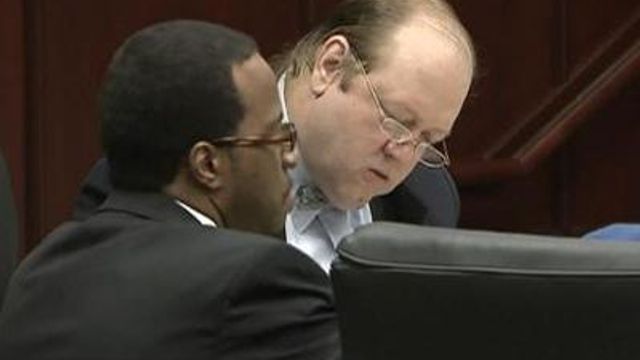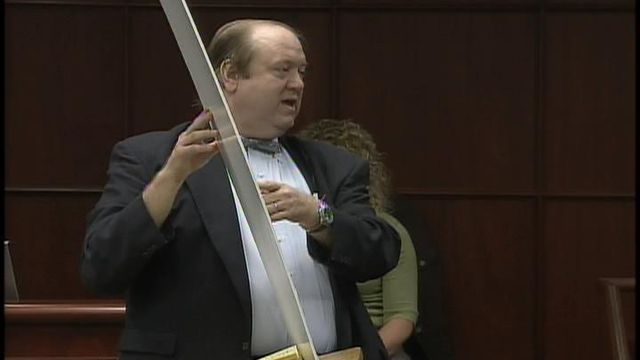Ex-pastor's defense casts doubt on state's case for murder
Robert Reaves's attorney told jurors during closing arguments that evidence suggested the former pastor's basketball-player roommate is a better candidate for having stabbed Latrese Curtis to death last year.
Posted — UpdatedThere was no blood in Reaves' car and investigators found a knife in the back of his car nine months after Curtis died that was never tested, attorney George Kelly told jurors during closing arguments.
Reaves' roommate, Steven Randolph, also had a knife collection and would have been more capable of holding back a woman fighting for her life than his client, Kelly said. Reaves is physically handicapped, they said, with a bad left hand.
Randolph is bigger and stronger, they suggested.
"She knows the end is coming. She's fighting. She's alive," he said. "Who's the better candidate – a basketball player, an NBA hopeful, or Robert Reaves, with a left hand and arm useless?"
Prosecutors have argued, however, that Reaves killed the 21-year-old North Carolina Central University student in a jealous rage because she was an obstacle to Reaves' sexual advances toward Randolph, with whom Curtis had been having sex.
Motorists found Curtis' body along eastbound Interstate 540 in Raleigh near the Louisburg Road exit on the morning of Jan. 30. She had been stabbed nearly 40 times in the head, neck, chest and stomach.
"The motive in this case was not a rebuffed sexual advance at all. (Reaves) approached Randolph. Randolph refused. (Reaves) moved on," Kelly said. "It was not a motive to kill. It was not a relationship. There was not an emotional bond whatsoever."
Prosecutors argued that Reaves' DNA couldn't be excluded from evidence taken from Curtis' steering wheel, but defense attorneys posed the question Wednesday of whether that could have been transferred from Reaves' home through Curtis. She had been at the home, visiting Randolph, on the night of Jan. 29.
A DNA sample taken from under Curtis' fingernails did not match Reaves, his other attorney, Margaret Lunden, said.
"That's undisputable. She scratched and broke her nails on somebody, but it was not Mr. Reaves," Lunden said. "There is simply not enough evidence to link Mr. Reaves to this crime scene. Scientific evidence weighs against it."
Prosecutors are not seeking the death penalty in this case, meaning that Reaves would face life in prison if he is found guilty of first-degree murder. Jurors also have the option to convict Reaves of second-degree murder.
Other defense and prosecution arguments centered on the timing of phone calls and home alarm records that pinpointed where Reaves might have been at the times before and after Curtis' death.
Part of the state's case was based on a state trooper's testimony that he saw Reaves' car at 1:36 a.m. on Jan. 30, around the same time that defense attorneys said Randolph told investigators that Reaves' car was at home. Reaves had told investigators no one else used the car.
Defense attorneys argued it was impossible for their client to have committed the crime, but they never explained how Reaves' car might have gotten on I-540 if Reaves was home at the time.
Another argument: a possible murder weapon found in Reaves' car nine months after an initial search. Prosecutors never connected the instrument to the wounds on Curtis' body, but a state pathologist testified it would have been possible for the knife to have inflicted the wounds.
Defense attorneys, however, said it was too small and implied that it was planted.
"There's just as much evidence in this case that it came to be in the car later than it was there already," Kelly said.
But Cummings scoffed at that argument, calling it nothing more than speculation. It was his job, he said, to present the facts and to let the jury decide.
"I’m not going to tell you this is the murder weapon. What I'm going to try to convince you was that it was found sometime later," he told jurors while holding the knife. "I'm sorry. I don't know why it was found later. Here it is. You can look at it. You can decide what that is."
Copyright 2024 by Capitol Broadcasting Company. All rights reserved. This material may not be published, broadcast, rewritten or redistributed.






